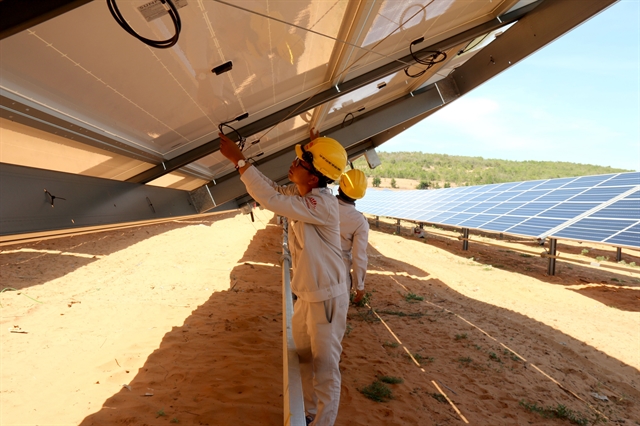The battery energy storage systems (BESS) could be a step in the right direction among the current solutions.

Việt Nam remains the fastest-growing energy market in the world, with the country's power demand projected to see annual power demand rise by 10–12 per cent through 2030.
This demand, combined with a push to cut emissions and embrace renewables, has resulted in grid instability and occasional power shortages, say industry insiders and experts.
They say battery energy storage systems (BESS) could be a step in the right direction among the current solutions. These systems can stabilise the grid by minimising renewable intermittency, improving flexibility, and ensuring a reliable supply.
Việt Nam Electricity (EVN) in August last year approved the country’s first BESS pilot project, a 50MW/50MWh facility developed in partnership with the Asian Development Bank (ADB), Rocky Mountain Institute (RMI), Global Energy Alliance for People and Planet (GEAPP), and the Việt Nam Energy Institute.
The project marks progress towards the government’s goal of developing 300MW of energy storage by 2030, as set out in the latest Eighth Power Development Plan (PDP8).
Experts say the rollout of battery storage often faces steep hurdles. High initial investment costs remain a significant barrier to large-scale adoption. Technical integration into the grid is complex and requires a solid regulatory foundation, which is still being finalised. Environmental concerns related to battery recycling and disposal also need to be addressed.
Despite these challenges, momentum is building thanks to domestic and international investment. At the Việt Nam-China-ASEAN International Energy Forum 2025, T&T Group’s Deputy CEO Nguyễn Thị Bình announced the group’s plan to launch joint-venture battery storage products in 2026.
The project’s first phase will have an annual production capacity of 2GWh, scaling up to 10GWh within three years. This manufacturing push is designed to meet expected demand once battery pricing and installation regulations are clarified.
T&T Group, already a major renewable investor with a portfolio of over 2,800MW across wind, solar, and LNG-to-power, is partnering with leading Chinese firms to fast-track the battery project. These include GEDI, Goldwind, and Envision, which are supporting T&T from early-stage research to construction and investment.
“Renewable energy is inherently unstable and poses certain challenges to the operation of the power system if deployed at a high proportion. However, when integrated with storage batteries, this weakness can be addressed.
"With relatively clear regulations recently, we firmly believe that the period from 2026 to 2030 will mark strong growth in the use of storage batteries for renewable energy projects,” Bình said.
The group aims to capture 40–50 per cent of the domestic market while also targeting exports to the US, Europe and regional neighbours. By 2035, T&T hopes to become Việt Nam’s leading energy investor and rank among Asia’s top 50, with a generation capacity of 16,000–20,000MW, primarily from clean sources.
Marubeni Corporation, through its subsidiary Marubeni Green Power Việt Nam, is also entering the battery storage space. It has launched a demonstration project in partnership with Vingroup, installing a VinFast Energy-developed BESS at a resort owned by the Vietnamese conglomerate. This project seeks to reduce electricity costs by leveraging time-of-use rate differences, one of the first such business models in Việt Nam.

Policy shift
Policy developments are reinforcing investor confidence. The amended PDP8, released in April, sets significantly higher targets for wind and solar.
Onshore and nearshore wind capacity is expected to reach up to 38,000MW by 2030, an increase of 20,000MW from previous targets, while offshore wind is set to add another 6,000MW. Solar capacity is projected to grow to as much as 73,416MW, including rooftop and utility-scale projects.
Notably, PDP8 now mandates that all new utility-scale solar plants incorporate battery storage equivalent to at least 10 per cent of the plant’s capacity for two hours of operation. Large-scale storage systems are also planned in regions with high renewable potential, such as the Central Highlands, Ninh Thuận and Bình Thuận.
Further support has come from the Ministry of Industry and Trade, which recently decided new electricity price frameworks for solar plants. For the first time, these include differentiated rates by region and separate pricing for systems integrated with battery storage.
Independent energy consultant Phan Xuân Dương described the change as a major policy shift, moving away from a one-size-fits-all approach and introducing incentives that reflect regional and technical realities.
Experts agreed that battery storage would play a transformative role in Việt Nam’s energy transition. Bình said the 2026–2030 period would be crucial for deployment, especially now that regulatory clarity was improving.
She acknowledged, however, that battery storage was still a high-barrier field. Global competitors, especially in China, had a decade-long lead in technology and scale, while Việt Nam currently lacked domestic manufacturers.
Bình said local production, supported by government incentives, could help level the playing field. T&T’s vision was to build Việt Nam into a manufacturing and technology hub for renewable energy equipment, especially in the green industrial parks being developed under government planning.
“I believe the Government will strongly encourage locally produced storage batteries, especially those invested in by Vietnamese investors, and there will certainly be supportive and preferential mechanisms to enhance competitiveness in the market,” she said. VNS





